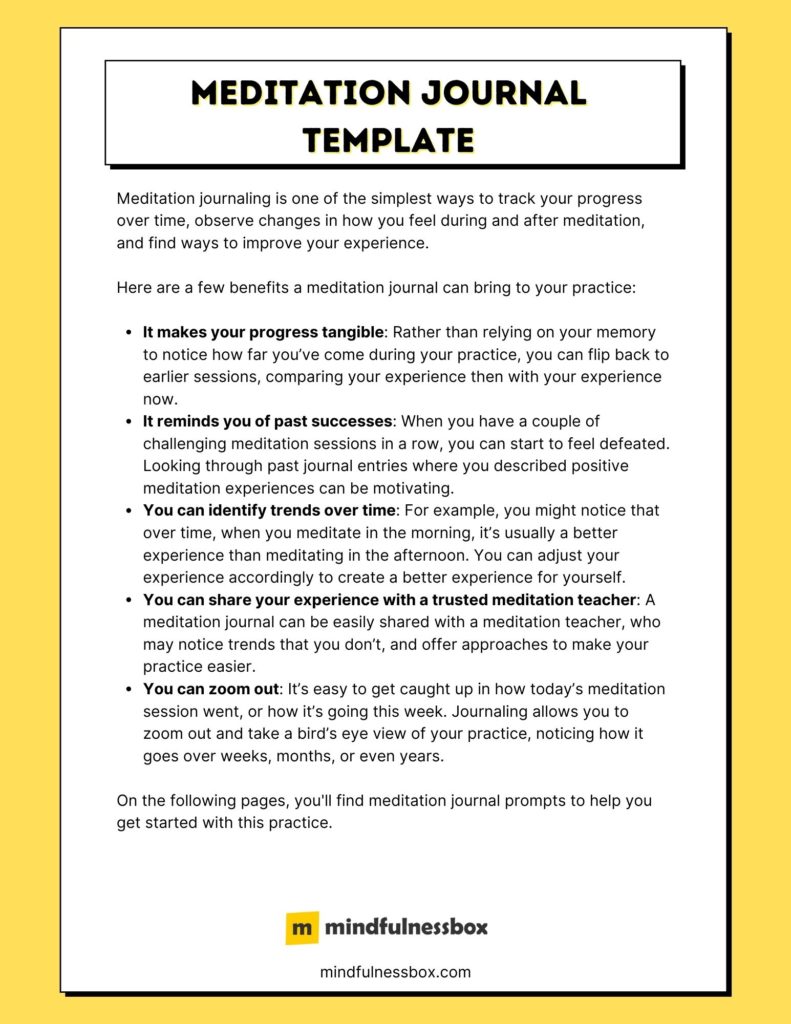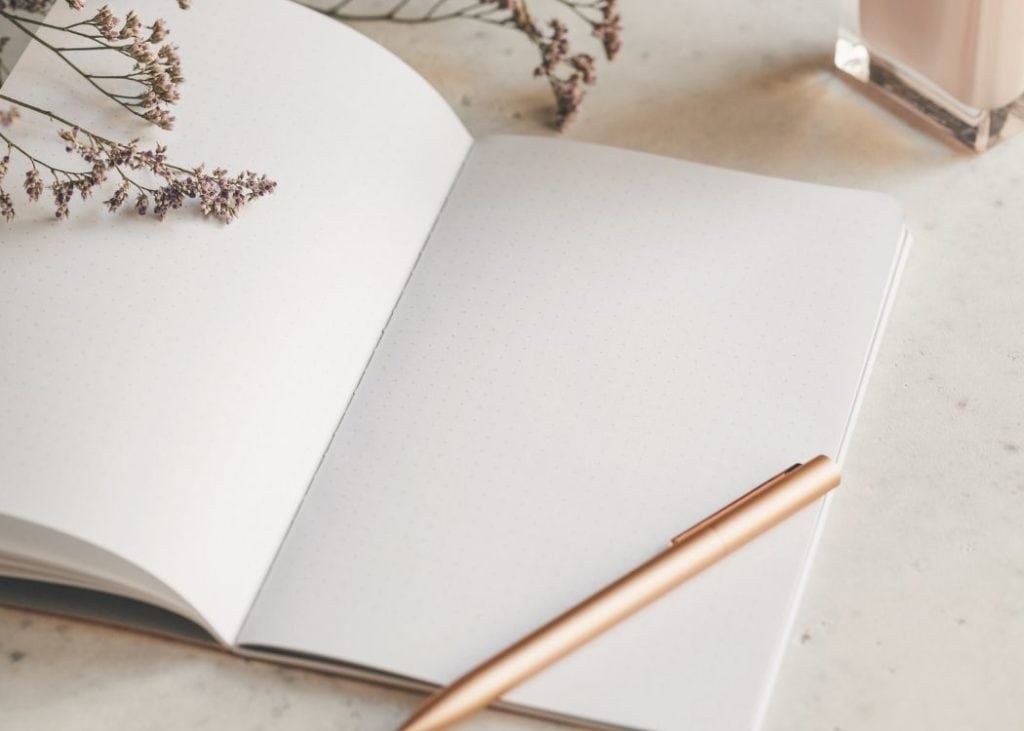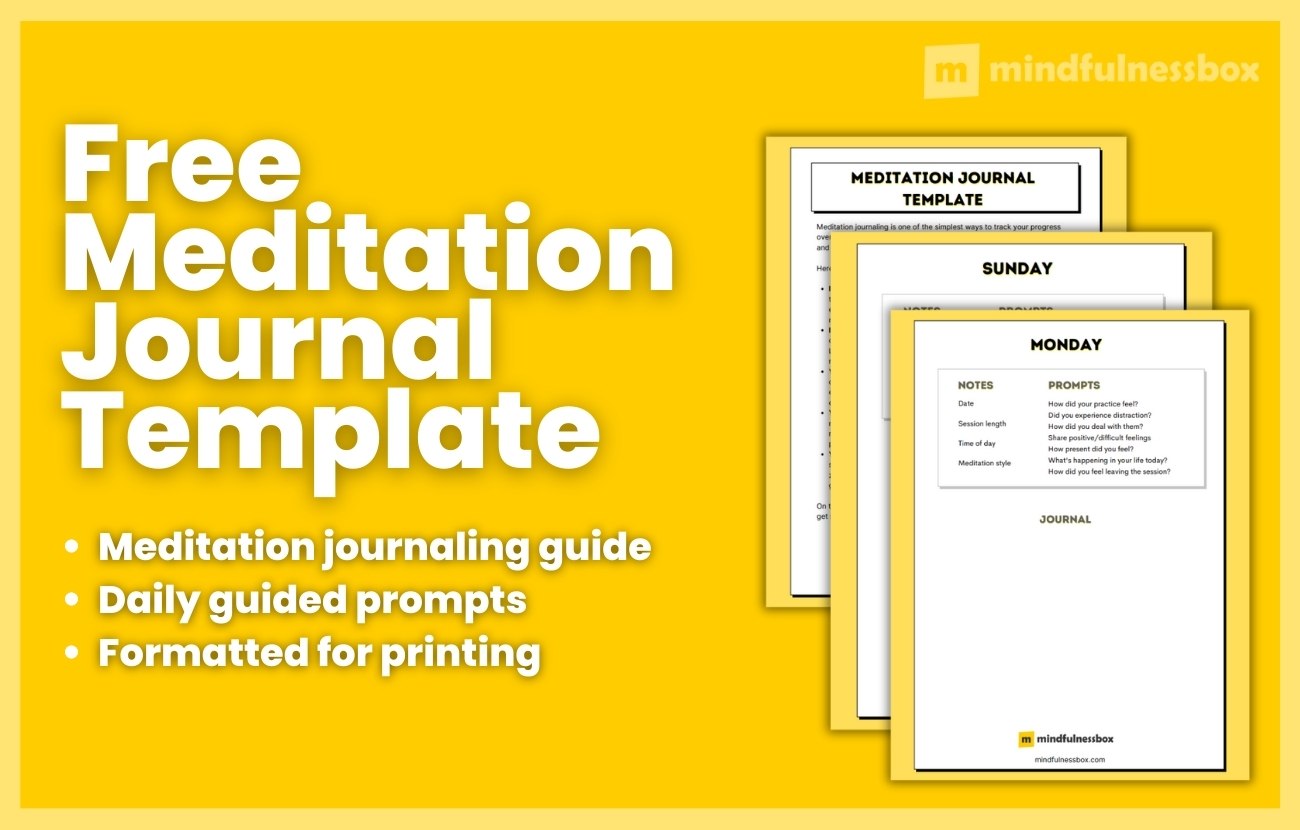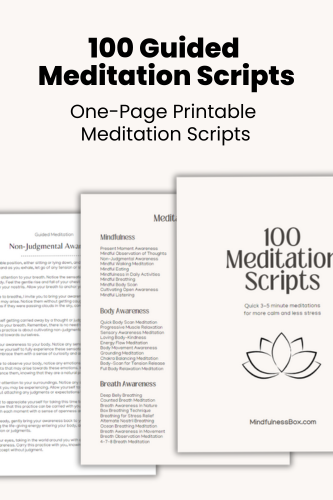Meditation journal templates make meditation journaling easy. If you’re looking to get started journaling about your meditation experience, keep it simple: grab a piece of paper or open a new note on your phone, and jot a few notes down about your experience. To make it even easier, use a meditation journal template and prompts.
If you’ve ever felt like you’re not sure you’re making progress in your meditation practice, you’re not alone. It takes time for meditation to start to “work.” And it can take even more time to notice changes in the way you experience your meditation practice, and the way that practice affects your daily experience.
These 100 meditation scripts were created to help beginner and intermediate meditators practice key mindfulness concepts like self-love, forgiveness, gratitude, and inner peace.
Designed to fit into busy schedules, each meditation script lasts 3-5 minutes. Perfect for starting or closing a group meditation; for yoga, coaching, or therapy sessions; or for your personal meditation practice.
Meditation journaling is one of the simplest ways to track your progress over time, observe changes in how you feel during and after meditation, and find ways to improve your experience.
The purpose of a meditation journal is to allow you to reflect on your experience and notice trends in your meditation practice. Anything that allows you to do that is an effective meditation journal.
Of course, if you prefer being more organized or working in a more structured environment, later in this article you’ll find prompts, examples, and a meditation journal template you can print out yourself as a PDF.
Let’s dive into the benefits of a meditation journal, some meditation reflection examples of the kinds of things you might write down, and a template to make it easy to get started.
Step 1: Download a meditation journal template
Sure, you can journal anywhere. But in case you’d like to make it a little easier, I’ve included a simple, free meditation journal template below. It’s a PDF.
Just download it and print. Or, feel free to copy and paste the questions into the note-keeping app of your choice to make your next meditation journaling session a little easier.
Here’s to reflecting, remembering your meditation successes, and building a meditation practice that can last for the long haul.

Step 2: Use meditation journal prompts
Wondering what exactly to write in your meditation journal?
Again, there’s no right or wrong approach to journaling meditation, but here are a few questions you might want to explore as you sit down with your journal:
- How did the practice go for you today?
- What distractions did you have?
- How did you deal with distractions?
- What positive feelings did you experience?
- What difficult feelings did you deal with?
- How present did you feel?
- Did anything going on in your life distract you?
The above meditation journal template includes prompts to help you with inspiration.
Step 3: When you get stuck, look at meditation journal examples

Let’s make it a little more concrete with meditation diary examples:
Day 1
Meditated for 15 minutes. My legs hurt. I was distracted for most of the beginning of the session. I started hearing voices from outside my house, and my mind focused on those. It was tough to bring it back. Towards the end of the session, I finally started to settle into a groove, but then the bell rang on my meditation timer. It felt like I almost got to a place of relaxation, but then, I didn’t get anywhere. I left the session feeling frustrated. Tomorrow I’m going to wear headphones and see if that helps.
Day 2
Meditated for 15 minutes. It was a little better than yesterday but not much. Wearing headphones helped to drown out the noises that distracted me yesterday. But the pressure of the headphones on my ears was another distraction. Again, my session started out with lots of distractions. My mind wandered endlessly from thought to thought. Lots of my thoughts were focused on the things I have to do later in the day. I have a very busy day coming up, so that might have something to do with the challenges today. A few times, I was able to remember to pull myself into the present moment. By the end of the session, my thoughts were just starting to settle down. Tomorrow, I’ll try meditating a little longer.
Day 3
Meditated for 20 minutes today. This meditation was actually pretty good. Like the last two days, I started feeling very distracted. I used my headphones and turned on meditation music to drown out outside distractions. My thoughts strayed away from the present moment towards distractions quite a bit. But around the 15 minute mark, my mind started to settle down. The last few minutes of the session were truly calm and relaxing. I left the meditation session with a feeling of calmness. It was a great way to start the day. This is a good formula for me.
Day 4
Meditated for 20 minutes today. Almost right away, my leg started to hurt. I couldn’t get into a comfortable position. I was hoping to reach the feeling of calm and relaxation from yesterday, but I never did. Maybe by trying to get there, I made it hard for me to actually get there. And in any case, I was distracted the whole time by my leg, and by the other distracted thoughts that normally pop into my head. I left the session feeling disappointed, because I thought I had figured out a formula that worked for me.
Day 5
Meditated for 20 minutes today. Today’s experience was pretty good. I didn’t have any leg pain like yesterday, and I was successful at bringing my attention back to the present moment when it strayed. I did that at least a handful of times that I remember. The last minute or two of the session, my mind felt more clear and I felt more relaxed.
The purpose of a meditation journal
The goal of a meditation journal is to record your experience of meditation over time so you can follow the ups and downs of your practice, and notice trends.
Here are a few benefits a meditation journal can bring to your practice:
- It makes your progress tangible: Rather than relying on your memory to notice how far you’ve come during your practice, you can flip back to earlier sessions, comparing your experience then with your experience now.
- It reminds you of past successes: When you have a couple of challenging meditation sessions in a row, you can start to feel defeated. Looking through past journal entries where you described positive meditation experiences can be motivating.
- You can identify trends over time: For example, you might notice that over time, when you meditate in the morning, it’s usually a better experience than meditating in the afternoon. You can adjust your experience accordingly to create a better experience for yourself.
- You can share your experience with a trusted meditation teacher: A meditation journal can be easily shared with a meditation teacher, who may notice trends that you don’t, and offer approaches to make your practice easier.
- You can zoom out: It’s easy to get caught up in how today’s meditation session went, or how it’s going this week. Journaling allows you to zoom out and take a bird’s eye view of your practice, noticing how it goes over weeks, months, or even years.
How to keep a meditation journal

To write in a meditation journal, get started by finding a blank piece of paper or a journal, or opening a note on your smartphone.
There are a few basics you might want to record for each session:
- The date
- How long you meditated
- The style of meditation you’re practicing
Once you’ve got those basics, simply start reflecting on your experience and write it down. There’s no right or wrong way to manage meditation and journaling. Write down whatever comes to mind, including positive experiences, challenges, comfort, discomfort, boredom, itchiness, a feeling of flow and being present–anything.
Something to be aware of:
When you start journaling about your meditation experience, you may find that this becomes an element of distraction in your meditation itself. Pay attention to whether you’re “rehearsing” during the course of your meditation for what you’ll journal. If you find yourself thinking during your meditation, “Ooh, that would be good to write down later,” try to gently pull yourself back to the present moment.
How long should a meditation journal entry be?
There’s no right or wrong answer here. A meditation journal can be as short or long as you need it to be. Anywhere from a couple of sentences to hundreds of words. It totally depends on your experience.
When you’re first starting out, you might want to keep it short. Making journaling a quick practice, where you just cover the basics in the course of a minute or two, can make it easier to cement it as a habit.
Frequently asked questions
Where can I find a meditation journal template?
You can find a free meditation journal template here. It’s a downloadable PDF including prompts and a bit of structure to get you started.
Note that meditation prompts for journaling are different from “regular” journaling and even mindfulness journal prompts. They’re focused specifically on your experience during and after meditation.
How can I download a meditation journal PDF?
Just click here to download your meditation journal PDF! It’s got everything you need to get your meditation journaling practice started.
Can I meditate by journaling?
Journaling can be a hugely useful tool to clear your mind and understand your patterns of thought.
Meditative journaling isn’t strictly “meditation,” but then again, anything can theoretically be meditation if you give your full, open awareness to it as an object of concentration. If you’re setting a goal to meditate by journaling, go into it with the intention to give your full focus and attention to your writing.
Notice when your thoughts stray even as you’re writing. (It’s incredible how much this happens, isn’t it?) When it happens, gently bring your thoughts back to the act of journaling.
What should I write after meditation?
After meditating, the best thing to write is a reflection of your experience during meditation. It’s entirely up to you what to include, but the best things to write are usually reflections that may be helpful to you later when looking back at your journal entry in the future.
For example, if you notice your mind was very distracted, but it started feeling clear at the end of the session, you might make a note to try meditating a little longer next time.
Keep track of the conditions of your meditation, from the length of your session to the time of day to your energy levels and the other things going on in your life.

My mindfulness practice kicked off in 2016 with a ten-day silent retreat. Since then, I’ve read dozens of books about mindfulness and completed hundreds of hours of meditation. Thinking about what makes humans happy, calm, and peaceful is endlessly fascinating to me.


